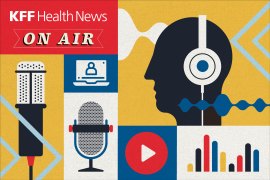Second WHO Probe Into Covid’s Origins Ends Just As The First: Inconclusively
It likely jumped from animals to humans, the experts said in their final report Friday. However, a critical component of the investigation was missing: Despite repeated requests, the group was not given access to Chinese data and therefore could not evaluate claims of a lab leak, AP reports.
AP:
COVID Origins Remain A Mystery After WHO Expert Investigation
An expert group charged by the World Health Organization to investigate how the COVID-19 pandemic started released its final report Friday, reaching an unsatisfying conclusion: Scientists still aren’t sure how the worst health emergency in a century began. At a press briefing on Friday, Marietjie Venter, the group’s chair, said that most scientific data supports the hypothesis that the new coronavirus jumped to humans from animals. (Cheng, 6/27)
CIDRAP:
WHO Adds XFG To SARS-CoV-2 Variants Under Monitoring
The World Health Organization (WHO) Technical Advisory Group on Virus Evolution (TAG-VE) on June 25 added the XFG to its SARS-CoV-2 variants under monitoring (VUM) list, as global proportions increase rapidly. In its initial risk assessment, the experts said the public health risk is currently low. XFG is one of many offshoots of the JN.1 subvariant, and the earliest sample was collected at the end of January. (Schnirring, 6/27)
On vaccines and measles —
Axios:
New Docs Get Schooled In Old Diseases As Vaccine Rates Fall
They may also have to brush up on best practices for spinal taps in infants and toddlers, an invasive diagnostic tool that is seldom used today but can quickly turn up telltale signs such as inflamed membranes, said Adrianna Cadilla, a pediatric infectious diseases specialist at Nemours Children's Health in Orlando. "When I trained, I would hear my attendings tell us about how often they had to do lumbar punctures because that was when Hemophilus influenza type B was running rampant," Cadilla said. "I only got to do probably one every ER shift, but that was a lot in comparison to now." (Reed, 6/30)
CNN:
What The First Meeting Of Kennedy’s CDC Advisers Reveals About The Future Of Vaccines In America
A startling new vision of vaccination in America is becoming clearer — one likely to involve fresh scrutiny of established science and practices, and limits on vaccines that have been studied for decades. (Goodman, Koda, Dillinger and Gumbrecht, 6/27)
CIDRAP:
World Leaders Pledge $9 Billion To Support Gavi's Vaccine Initiatives
In the wake of US defunding of Gavi, the Vaccine Alliance, world leaders this week at the "Health and Prosperity through Immunisation" global summit in Brussels pledged €7.7 billion ($9 billion US) to support the group, according to a joint press release posted by the European Commission (EC). Gavi's target budget for 2026 through 2030 is €10.2 billion ($12 billion). (Wappes, 6/27)
KFF Health News:
A Texas Boy Needed Protection From Measles. The Vaccine Cost $1,400
In the early days of the West Texas measles outbreak, Thang Nguyen eyed the rising number of cases and worried. His 4-year-old son was at risk because he had received only the first of the vaccine’s two doses. So, in mid-March, he took his family to a primary care clinic at the University of Texas Medical Branch in Galveston. By the end of the visit, his son, Anh Hoang, had received one shot protecting against four illnesses — measles, mumps, rubella, and chickenpox. (Appleby, 6/30)
AP:
Measles Outbreaks: Updates On Case Counts Across The US
Michigan has its second measles outbreak of the year, Utah has seven cases and health workers in New Mexico are rushing to contain an outbreak in a county jail. But for the first time in months, Texas confirmed no additional measles cases this week tied to a major outbreak that raged through the late winter and spring. There have been 1,227 confirmed measles cases this year, the Centers for Disease Control and Prevention said Wednesday. (Shastri, 6/27)
AP:
Families Share Their Stories Of Damage Done By Vaccine-Preventable Diseases Like Measles And Rubella
In the time before widespread vaccination, death often came early. Devastating infectious diseases ran rampant in America, killing millions of children and leaving others with lifelong health problems. These illnesses were the main reason why nearly one in five children in 1900 never made it to their fifth birthday. Over the next century, vaccines virtually wiped out long-feared scourges like polio and measles and drastically reduced the toll of many others. Today, however, some preventable, contagious diseases are making a comeback as vaccine hesitancy pushes immunization rates down. (Ungar, 6/28)
Also —
Politico:
Can ‘Ohio’s Anthony Fauci’ Beat Vivek Ramaswamy?
Amy Acton oversaw public health for Ohio during Covid. Can she become governor? (Skalka, 6/28)






